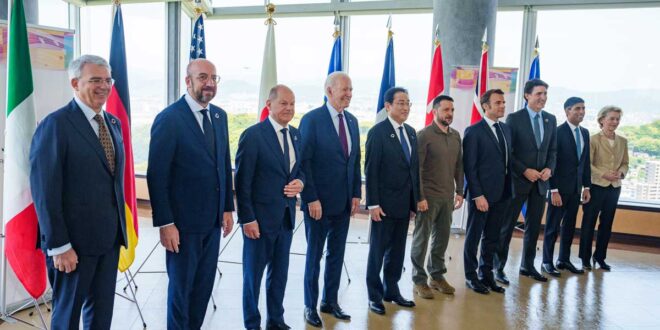Peter Rudgers
The G7, an informal group of seven wealthy Western nations, has been struggling to maintain its relevance and influence in the changing global order. Facing the challenges posed by China and Russia, which seek to alter the existing order and challenge the interests of the West, the G7 has adopted a new strategy: to become an economic NATO that links economic security to military security and restricts trade and investment with non-allies. This strategy reflects the US’s attempt to revive its leadership of the free world and to counter both China and Russia by mobilizing its allies in Europe and Asia. However, this strategy is flawed and risky, as it ignores the realities of a multipolar world and the benefits of cooperation over confrontation.
The G7 originated as a forum for economic coordination in the 1970s, when the world faced severe economic challenges such as the oil crisis and the breakdown of the Bretton Woods system. In the 1980s, the G7 expanded its agenda to include foreign and security policy issues, such as terrorism, nuclear proliferation, and human rights. In 1998, Russia joined the group, turning it into the G8, but its membership was suspended in 2014 after its annexation of Crimea and violation of Ukraine’s sovereignty.
The Ukraine crisis was a turning point for the G7, as it exposed the limitations of the broader G20 group, which includes emerging powers such as China, India, Brazil, and South Africa. The G20 was created in 2008 in response to the global financial crisis, but it failed to provide a unified response to the Ukraine crisis, as some of its members did not condemn Russia’s aggression or support sanctions against it. Therefore, the US and its allies decided to revive the G7 as a platform for aligning their interests and values against their adversaries.
The G7 has since become an economic NATO that seeks to defend the interests of the West by linking economic security to military security. This idea was first suggested by Liz Truss, the former British foreign minister, as an economic strategy for the West to counter China’s rising economic power. The idea is that if an aggressor state attacks the economy of one of the partners, NATO and the G7 will jointly support the affected ally based on Article 5 of Military and Economic NATO. The proponents of this idea argue that it would deter potential violators by making them aware of the costs of violation and by reducing the time delays in applying sanctions and economic penalties.
The G7’s transformation into an economic NATO was evident at its latest meeting in Hiroshima, Japan, where it issued a statement that challenged China’s claims in the South China Sea, called for nuclear talks with Beijing, expressed support for Ukraine, and denounced Russia’s nuclear activities. The statement came at a time when the G7 countries had initiated a military buildup in Southeast Asia and expressed alarm over China’s growing military presence and nuclear capabilities in the South China Sea3. They also voiced concern over China’s development and deployment of more advanced military equipment.
The G7 also called on Beijing to swiftly engage in talks with the US on reducing its nuclear weapons programs and capabilities to lower strategic risks and foster stability through more transparency in its security policies. This is while these seven countries have pursued complications of security issues and nuclearization of the region under the AUKUS Agreement.
The G7 expressed its unwavering support for Ukraine and its willingness to impose stronger sanctions on Moscow. It also pledged to coordinate efforts to prevent the supply of arms from third countries to Russia and to take measures against those who assist Russia’s aggression against Ukraine. Regarding the peace proposal put forward by Beijing, the group stressed that it would not endorse any peace settlement that fails to ensure the full withdrawal of Russian forces from Ukraine, the compensation of all damages inflicted by the war, and the accountability of war crimes such as attacks on civilians and critical infrastructure in Ukraine.
The G7 denounced Russia’s intention to conduct nuclear tests, its withdrawal from the New Start Treaty, and its plan to deploy nuclear weapons in Belarus. It also cautioned against the repercussions of using any weapons of mass destruction in response to Russia’s repeated nuclear threats.
The G7’s statement reflects its Cold War mentality and its aim to restrain rising countries such as China and Russia. However, this strategy is flawed and risky, as it ignores the realities of a multipolar world and the benefits of cooperation over confrontation.
First, the G7’s strategy is based on the assumption that it can maintain its economic and military dominance over the rest of the world. However, this assumption is questionable, as the G7’s share of global GDP has declined from 65% in 1980 to 40% in 20204. Moreover, the G7 faces internal challenges such as Brexit, populism, inequality, and debt. The G7 also depends on trade and investment with China and other emerging markets for its economic growth. Therefore, the G7 cannot afford to isolate itself from the rest of the world or to antagonize its major trading partners.
Second, the G7’s strategy is based on the premise that it can rally its allies in Europe and Asia to confront China and Russia. However, this premise is doubtful, as some of its allies have divergent interests and views on China and Russia. For example, Germany and France have opposed the US’s hardline approach to China and have sought to pursue dialogue and cooperation with Beijing on issues such as climate change, trade, and investment. Similarly, some Asian countries such as South Korea, Indonesia, and Thailand have maintained cordial relations with China and have been reluctant to join the US-led security initiatives in the region. Therefore, the G7 cannot assume that it can speak for or lead its allies in a unified front against China and Russia.
Third, the G7’s strategy is based on the notion that it can achieve its goals by using sanctions and economic penalties against China and Russia. However, this notion is dubious, as sanctions and economic penalties have proven to be ineffective or counterproductive in changing the behavior of China and Russia. For instance, the US-led sanctions against Russia over its annexation of Crimea have not deterred Russia from continuing its aggression in Ukraine or from interfering in other countries’ affairs. On the contrary, the sanctions have pushed Russia closer to China and have increased its resilience and self-reliance. Similarly, the US-led trade war against China has not forced China to make concessions on its trade practices or its policies on Hong Kong, Taiwan, or Xinjiang. Instead, the trade war has harmed both economies and has intensified their strategic rivalry.
The G7’s strategy of becoming an economic NATO is a misguided and dangerous one that will only worsen the global situation and undermine its own interests. Instead of pursuing confrontation and coercion, the G7 should seek cooperation and compromise with China and Russia on common challenges such as climate change, pandemic response, nuclear non-proliferation, and regional stability. The G7 should also respect the diversity and multiplicity of the world and engage with other actors such as the G20, the BRICS, and regional organizations. The G7 should recognize that it is no longer the sole or dominant force in global affairs and that it needs to adapt to the new realities and the new opportunities of a multipolar world.
 Geostrategic Media Political Commentary, Analysis, Security, Defense
Geostrategic Media Political Commentary, Analysis, Security, Defense





